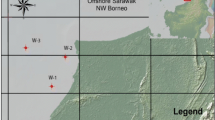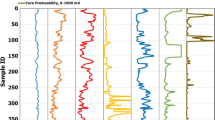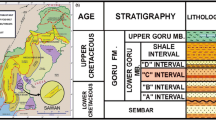Abstract
Here, we suggest the use of the artificial neural network for permeability prediction in horizontally drilled well in unconventional shale gas reservoirs. Prediction of Permeability in shale gas reservoirs is a complicated task that requires new models where Darcy’s fluid flow model is not suitable. The proposed idea is based on the training of neural network machine using the set of well-logs data as an input and the measured permeability, from Javadbour model, as an output. In this case, the multilayer perceptron neural network machine was used with Levenberg Marquardt algorithm. Application to two horizontal wells drilled in the Barnett shale formation exhibits the power of the neural network model to enhance unconventional reservoir characterization.
Access provided by Autonomous University of Puebla. Download conference paper PDF
Similar content being viewed by others
Keywords
1 Introduction
Currently, unconventional reservoir characterization is an important task and challenge in the petroleum domain. It requires advanced technologies for their evaluation and extraction (Zee Ma and Holditch 2016; Aliouane and Ouadfeul 2013). Shale gas unconventional reservoirs and their permeability are still poorly understood where unconventional gas is found in reservoirs with relatively low permeabilities (less than 1 mD) and hence cannot be extracted via conventional methods. For that, we suggest the use of artificial intelligence such as neural network (ANN) for permeability prediction. Since, the ANN's techniques have been widely used to estimate conventional permeability (Aliouane et al. 2018). These techniques need just to be trained by training data. In our study, the well-logs of two horizontal wells, H1 and H2 in the Barnet shale from the Worth Basin, were used as input of neural network MLP model both for training and generalization. The obtained results will be compared to those obtained by Javadbour’s relationship.
2 Data Description and Permeability Estimation Using Javadbour’s Model
The raw well-logs data of two horizontal wells drilled in the Barnett shale located in the Ft Worth basin are exploited: total natural gamma (GR), bulk density (RHOB), neutron porosity (NPOR), transit time of P wave (DTCO), and transit time of S wave (DTSM). Figure 1 shows the raw well-logs data in tracks 2, 3, 4, 5, and 6. The recordings show that this reservoir is radioactive and tight by its low values of DTCO and DTSM.
Concerning the permeability computation, many authors have proposed many empirical relationships considering that the permeability in shale gas reservoirs is thought to be analogous to very tight sandstones (Moore et al. 2016). Such reservoirs consist of extremely tight formations through which transport of gas occurs by different mechanisms depending on the flow and porous formation conditions (Javadpour 2009; Civan et al. 2011; Haghshenas et al. 2013). Jenkins (2015) has shown the difficulty to estimate this parameter, mainly, in anisotropic permeability due to reservoir pressure change where it requires the confining stress method. In our study, permeability has been estimated using the Javadbour equation (Javadpour 2009) in the Barnet shale of the two horizontal wells. The results of one well (H01) are shown in Fig. 1 track 7.
3 Permeability Prediction by Multilayer Perceptron Neural Network
The multilayer perceptron neural network machine (Aminian and Ameri 2005) with Levenberg Marquardt training algorithm (Aliouane et al. 2014) has been implemented for the prediction of the permeability in shale gas reservoirs. The 05 raw well-logs data, cited below, are used as an input in the input layer with 05 neurons, and the estimated permeability from Javadbour’s equation is used as an output to train a neural network MLP for the output layer with one neuron (K_Predicted). The neural machine is trained in a supervised mode, and weights of connections are calculated during the training stage. The raw well-logs data are then injected in this machine, and an output is calculated using the weight of connections (Fig. 2).
4 Results Analysis and Conclusion
We can observe that the proposed MLP machine is able to provide very good results that are very close to the reality (Fig. 2). It is clear that the implanted machine is able to provide very good and realistic results.
The implantation of this neural network machine enabled us to predict the permeability without the need to use Javadpour’s relationship or another mathematical relationship that requires laboratory measurements of many rock parameters which are expensive and require financial support. We suggest testing the multilayer perceptron neural network machine to data of other horizontal wells drilled in the Barnett shale and that are close to the pilot well 01H to check its efficiency and generalize to weights of connection.
References
Aliouane, L., Ouadfeul, S, Djarfour, D., Boudella, A.: Permeability prediction using artificial neural networks. A comparative study between back propagation and Levenberg–Marquardt learning algorithms. In: Pardo-Igúzquiza, E., et al. (eds.) Mathematics of Planet Earth, Lecture Notes in Earth System Sciences. Springer, Berlin (2014)
Aliouane, L., Ouadfeul, S.: Sweet spots discrimination in shale gas reservoirs using seismic and well-logs data. A case study from the Worth basin in the Barnett shale. Energy Procedia (2013)
Aliouane, L., Ouadfeul, S.D., Boudella, A.: Back propagation and hidden weight optimization algorithms neural network for permeability estimation from well-logs data in Shaly Sandstone petroleum reservoirs: application to Algerian Sahara. In: Advances in Petroleum Engineering and Petroleum Geochemistry, Proceedings of the 1st Springer CAGJ, pp. 25–27. Tunisia (2018)
Aminian, K., Ameri, S.: Application of artificial neural networks for reservoir characterization with limited data. J. Petrol. Sci. Eng. 49, 212–222 (2005)
Civan, F., Rai, C.S., Sondergeld, C.H.: Shale permeability determined by simultaneous analysis of multiple pressure-pulse measurements obtained under different conditions. SPE paper 144253 presented at SPE North American Unconventional Gas Conference and Exhibition, The Woodlands, Texas (2011)
Haghshenas, B., Clarkson, C.R., Chen, S.: Multi-Porosity, Multi-Permeability Models for Shale Gas Reservoirs. SPE Unconventional Resources Conference-Canada, SPE 167220 (2013)
Javadpour, F.: Nanopores and apparent permeability of gas flow in Mudrocks (shales and siltstone). J. Can. Pet. Technol. 48, 16–21 (2009)
Jenkins, W.: Porosity and Permeability in tight rock. Thesis, Charles Darwin University (2015)
Moore, W.R., Zee Ma, Y., Pirie, I., Zhang, Y.: Tight Gas Sandstone Reservoirs, Part 2: Petrophysical Analysis and Reservoir Modeling. Elsevier (2016)
Zee Ma, Y., Holditch, S.A.: Unconventional Oil and Gas Handbook. Evaluation and Development. Elsevier (2016)
Author information
Authors and Affiliations
Corresponding author
Editor information
Editors and Affiliations
Rights and permissions
Copyright information
© 2022 The Author(s), under exclusive license to Springer Nature Switzerland AG
About this paper
Cite this paper
Aliouane, L., Ouadfeul, SA., Boudella, A. (2022). Unconventional Reservoir Characterization: Permeability Prediction in Shale Gas Reservoirs from Well-Logs Data Using Neural Network. Application to the Barnett Shale (USA). In: Meghraoui, M., et al. Advances in Geophysics, Tectonics and Petroleum Geosciences. CAJG 2019. Advances in Science, Technology & Innovation. Springer, Cham. https://doi.org/10.1007/978-3-030-73026-0_99
Download citation
DOI: https://doi.org/10.1007/978-3-030-73026-0_99
Published:
Publisher Name: Springer, Cham
Print ISBN: 978-3-030-73025-3
Online ISBN: 978-3-030-73026-0
eBook Packages: Earth and Environmental ScienceEarth and Environmental Science (R0)






